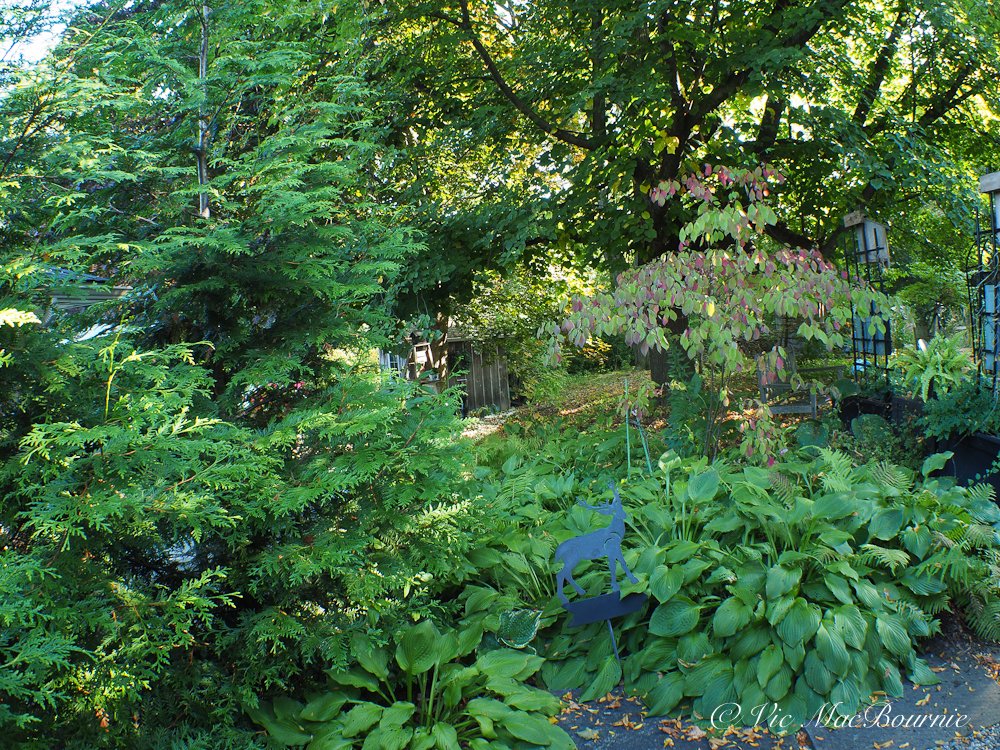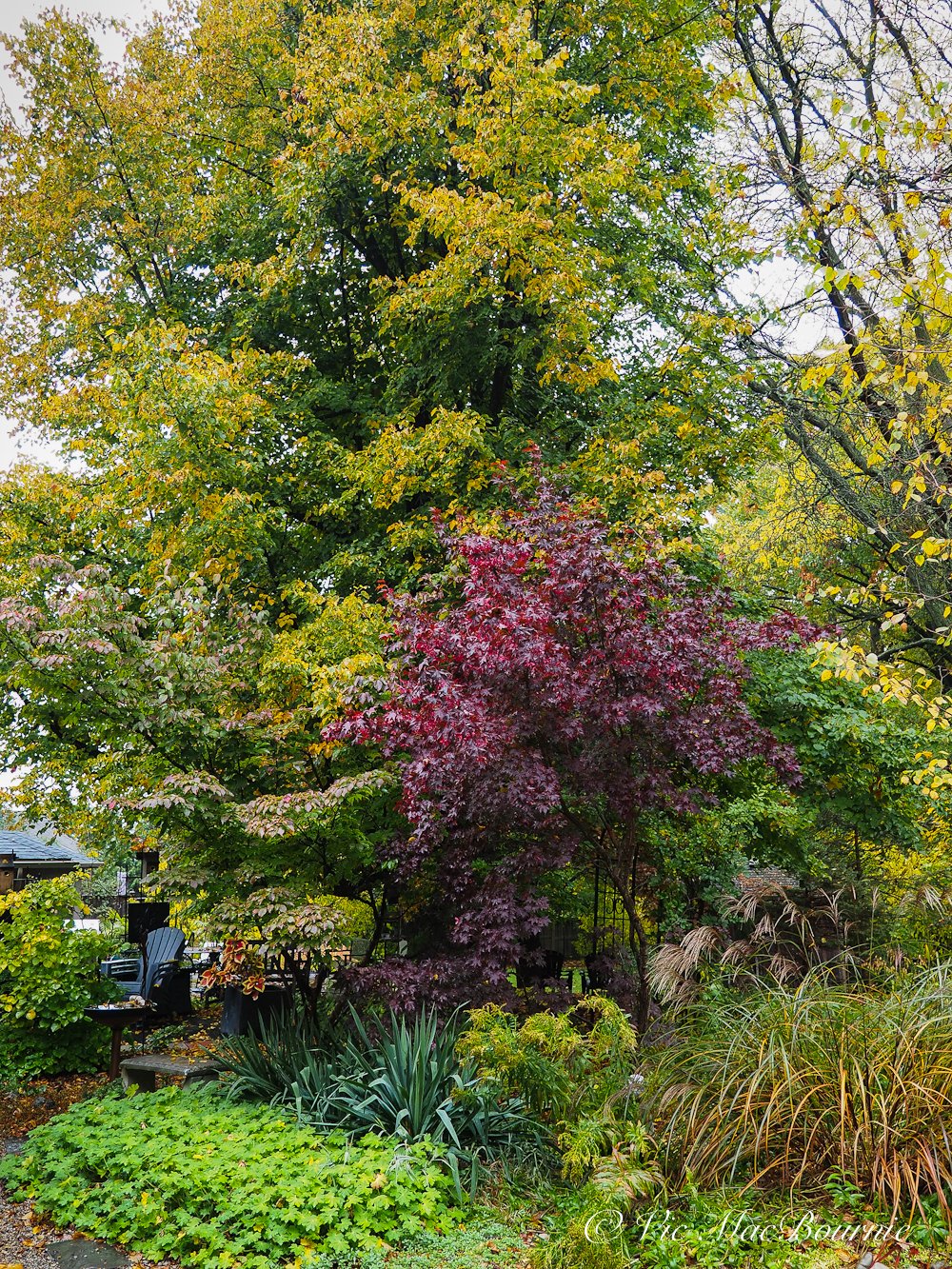Linden tree: A stalwart in our woodland garden
How Lindens help wildlife in our yards
Not a day goes by that I don’t appreciate the beauty of our mature Linden tree in the backyard. It stands on the edge of our property just outside our family room where I can observe the many comings and goings as it changes from season to season.
It’s a favourite of our squirrels – both red and grey – backyard birds and raccoon families that use its dense branches and leaves for nesting and hiding out from summer’s full sun.
It’s not uncommon to watch our hummingbird feed from one of our feeders and then head up into the safety of our Linden tree where it can rest high in the tree’s branches or feed from its fragrant spring flowers.
Actually, Lindens have always been a part of my life.
As a child, I watched our little Linden grow up in front of me from a tiny sapling into a fully mature tree that now dominates the front of my childhood home. It became the climbing tree for my nephews and a shady play spot and picnic area for my daughter and her cousins whenever they came to visit grandma and grandpa.
In spring and summer it provides a deep shade for many of our native wildflowers, from wild geraniums to trilliums, violets and Mayapple. Our ferns and hostas also thrive in the deep shade of our massive tree.
Our Linden was a mature tree – towering above our one-storey home – when we purchased it more than 25 years ago. Little leaf Lindens can grow to about 80 feet tall (24m) with a spread between 40 to 50 feet (15m). In most urban landscapes Linden’s normally grow 40 to 50 feet (15m) tall with a 35- to 40-foot-spread.
Lindens take on a very attractive pyramidal form as they age (as seen in the larger image above). This creates a large shaded area below, making them an ideal spot for a garden bench, sitting area or small dining area.
They would be considered by some to be a little messy dropping their flowers in spring followed by small, ball-like seeds later in the year. Of course, their dense leaf cover creates a lovely deep yellow, natural groundcover in fall after they shed their leaves. I just leave them on the ground for the wildlife to use.
In spring, its bright green leaves combine with our neighbour’s mature Crimson maple leaves creating a lovely contrast that lasts throughout the growing season and create effective habitat for a host of wildlife.
How do you identify linden tree leaves?
Linden tree leaves have distinct identifying characteristics that set them apart from other tree leaves.
The key feature is their heart-shaped form, with a pointed tip and a rounded base. The edges of the leaves are serrated or toothed, adding to their unique appearance.
Another distinguishing trait is the asymmetrical leaf base, where one side is slightly larger than the other.
In terms of size, linden tree leaves are typically medium to large, ranging from 2 to 6 inches in length.
They have a smooth texture and a glossy surface, which gives them a vibrant and attractive look in the landscape. The color of the leaves varies throughout the year, transitioning from a fresh green in spring and summer to a vibrant yellow in the fall.
To further identify linden tree leaves, you can also examine the leaf veins. The veins are prominently visible and radiate from the central midrib toward the edges of the leaf. This venation pattern is characteristic of linden trees and can help distinguish their leaves from those of other tree species.
What is special about a linden tree?
Little Leaf Lindens are excellent trees to create shade in your garden.
Their dense foliage and broad canopy provide ample shade, making them a popular choice for homeowners and landscapers alike.
But what makes linden trees truly special goes beyond their shade-providing abilities.
Fragrant flowers attract bees, butterflies and even hummingbirds
One remarkable feature of linden trees is their fragrant flowers.
In late spring and early summer, linden trees produce clusters of small, yellowish-white flowers that emit a sweet, intoxicating scent. These flowers not only add beauty to the tree but also attract a variety of pollinators, including bees and butterflies.
The nectar-rich blossoms serve as a valuable food source for these insects, supporting their populations and contributing to the overall biodiversity of the area.
Medicinal uses of Linden trees and leaves
Linden leaves have long been used in traditional medicine for their calming and soothing effects.
They are often brewed into herbal teas that are believed to promote relaxation and alleviate stress. Additionally, linden leaves are known for their anti-inflammatory properties and can be used topically to soothe skin irritations and reduce swelling.
In conclusion, linden trees are not only beautiful shade trees but also play a vital role in supporting wildlife and providing medicinal benefits.
Whether you're looking to enhance your garden’s aesthetics or create a peaceful retreat, a linden tree is a special addition that will bring numerous benefits to your outdoor space.
Are linden trees native to the U.S. and Canada?
Linden trees can be grown in a variety of zones in both Canada and the United States, but are native to Europe and Asia.
These trees are adaptable and can thrive in different climates and conditions.
The ability of linden trees to grow in different zones makes them a popular choice for homeowners and gardeners looking to add beauty and shade to their landscapes. Whether you live in Canada or the United States, you can enjoy the benefits of linden trees in your garden or outdoor space.
In the United States, linden trees can be grown in zones 3 to 8, making them suitable for a wide range of states. From the northern states like Minnesota and Maine to the southern states like Texas and Florida, linden trees can be found in various regions across the country.
In Canada, linden trees can be grown in zones 2 to 7, which cover a large portion of the country. This means that linden trees can be enjoyed in regions such as British Columbia, Alberta, Ontario, and Quebec, among others.
With their attractive foliage, fragrant flowers, and the wildlife they support, linden trees are a valuable addition to any garden or woodland area. So, if you're considering planting a linden tree, rest assured that it can thrive in the appropriate growing zones in both Canada and the United States.
What are linden leaves good for?
Linden leaves are not only beautiful, but they also have several practical uses.
One of the main benefits of linden leaves is their medicinal properties. These leaves have been used for centuries in traditional medicine to treat various ailments. They are known for their calming and soothing effects, making them a popular choice for herbal teas and infusions.
Linden leaf tea is often consumed to help with anxiety, stress, and insomnia.
In addition to their medicinal uses, linden leaves are also beneficial for the environment. They are rich in nutrients and can be used as a natural fertilizer for plants. By composting linden leaves, you can enrich the soil and promote healthy plant growth.
Linden are host plant for certain insects and caterpillars
Furthermore, linden leaves are a valuable food source for certain insects and caterpillars. They provide nourishment for species such as the linden looper moth and the linden hawk moth. These insects play an important role in the ecosystem as pollinators and as a food source for other animals.
So, while linden trees are admired for their shade and fall color, their leaves offer even more benefits. From their medicinal properties to their role in supporting wildlife, linden leaves are truly valuable. Whether you’re enjoying a cup of linden leaf tea or observing the insects that depend on them, linden leaves are a wonderful asset to have in any garden or woodland area.
What animals, insects, and birds depend on Linden
These trees attract a wide range of animals, insects, and birds, making them an important part of any woodland garden or natural habitat.
One of the main beneficiaries of linden trees are butterflies. Species such as the Eastern Tiger Swallowtail and the Red-spotted Purple rely on linden trees as a food source for their caterpillars. The leaves of the linden tree provide nourishment and support the growth of these beautiful butterflies.
In addition to butterflies, linden trees also attract a variety of birds. Species like the American Goldfinch and the Ruby-throated Hummingbird are known to visit linden trees for their nectar-rich flowers. These birds play a crucial role in pollination and contribute to the overall health of the ecosystem.
Furthermore, linden trees provide shelter and food for mammals as well. Squirrels and chipmunks are often seen scurrying up and down the trunks of linden trees, collecting seeds and nuts.
These trees also offer a safe haven for nesting birds and provide a habitat for small mammals like bats.
Linden tree: An ideal tree for a woodland garden
In conclusion, linden trees are not only visually appealing but also support a diverse range of wildlife. From butterflies and birds to mammals, these trees play a vital role in providing food, shelter, and habitat for various species. By planting linden trees, you can create a thriving ecosystem in your own backyard.




